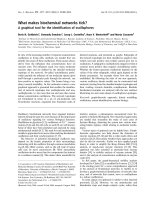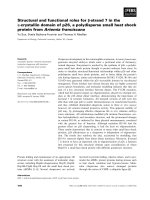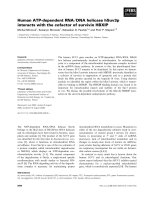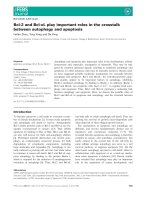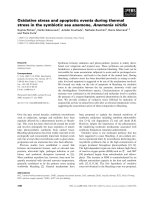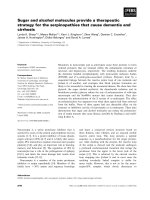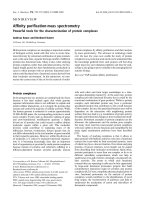Báo cáo khoa học: "Pro/con clinical debate: Steroids are a key component in the treatment of SARS" pps
Bạn đang xem bản rút gọn của tài liệu. Xem và tải ngay bản đầy đủ của tài liệu tại đây (41.39 KB, 3 trang )
105
ARDS = acute respiratory distress syndrome; ICU = intensive care unit; IL = interleukin; SARS = severe acute respiratory syndrome.
Available online />Unfortunately, in the winter of 2004 SARS (severe acute
respiratory syndrome) emerges in the world once again, and
health care workers in your institution begin to develop the
illness. Patients with SARS start to develop critical illness and
you are asked to become involved in their care. You have read
that during the first outbreak of SARS steroids were a commonly
employed therapy. Despite this you worry about the adverse
effects of steroid therapy, especially in critically ill patients.
Review
Pro/con clinical debate: Steroids are a key component in the
treatment of SARS
Charles D Gomersall
1
, Marcus J Kargel
2
and Stephen E Lapinsky
3
1
Associate Professor, Department of Anaesthesia and Intensive Care, The Chinese University of Hong Kong, Prince of Wales Hospital, Shatin,
Hong Kong
2
Critical Care Fellow, Interdepartmental Division of Critical Care, University of Toronto, Toronto, Ontario, Canada
3
Site Director, Intensive Care Unit, Mount Sinai Hospital and Associate Professor of Medicine, Interdepartmental Division of Critical Care, University of
Toronto, Toronto, Ontario, Canada
Correspondence: Critical Care Editorial Office,
Published online: 26 January 2004 Critical Care 2004, 8:105-107 (DOI 10.1186/cc2452)
This article is online at />© 2004 BioMed Central Ltd (Print ISSN 1364-8535; Online ISSN 1466-609X)
Abstract
SARS (severe acute respiratory syndrome) proved an enormous physical and emotional challenge to
frontline health care workers throughout the world in late 2002 through to mid 2003. A large
percentage of patients (many being health care workers themselves) became critically ill. Unfortunately,
clinicians caring for these individuals did not have the advantage of previous experience or research
data on which to base treatment decisions. As a result, at least early in the outbreak, a ‘best guess
approach’ and/or anecdotes drove therapy. In many centres systemic steroids, which carry many
potential downsides, became a mainstay of therapy. In this issue of Critical Care, two groups that have
frontline experience of SARS debate the role of steroids. Let us hope and pray together that we never
have the patient population needed to resolve the questions the two sides raise.
Keywords critical care, respiratory failure, SARS, steroids, viral pneumonia
Pro: Yes, steroids are a key component of the treatment regimen for SARS
Charles D Gomersall
SARS is a potentially life-threatening disease caused by
infection with SARS coronavirus. The early phase of the disease
appears to be due to the virus itself whereas the later phase is
thought to be due to an inflammatory response. Quantitative
reverse transcriptase polymerase chain reaction of
nasopharyngeal aspirates has shown that the viral load peaks at
about 10 days from symptom onset [1], and serum
concentrations of IL-6, IL-8, IL-16 and tumour necrosis factor-α
are most markedly raised 8–14 days from disease onset [2]. In
addition, the histological changes in the lungs of patients who
died from SARS suggest cytokine dysregulation [3]. Thus, the
available data suggest that the clinical manifestations of SARS
in the second week of illness are predominantly due to an
excessive immune response to viral infection rather than to
infection itself. Because admission to the intensive care unit
(ICU) occurs 8–9 days after symptom onset and the median
duration of ICU stay is 8.5–14.5 days [4–6], it is likely that most
critically ill patients are in this immunological phase. Therefore, a
logical approach is to modify the immune response with anti-
inflammatory agents such as corticosteroids.
The scenario
106
Critical Care April 2004 Vol 8 No 2 Gomersall et al.
The majority of critically ill patients with SARS develop acute
respiratory distress syndrome (ARDS); not only do the vast
majority meet the criteria for ARDS [4–6] but also computed
tomography of the lungs 22–54 days after the onset of
ARDS shows changes consistent with late phase ARDS [7].
Data from other patients with ARDS suggest that high-dose
corticosteroids may have a beneficial effect in those who fail
to improve by day 7 of respiratory failure [8]. Other ARDS
data indicate that steroids do not worsen outcome despite
the inclusion of patients with ARDS due to sepsis, and that
the incidence of infectious complications is unaffected by the
administration of very high doses of corticosteroid [9].
Finally, in other viral pneumonias corticosteroids may be of
benefit. In a rat model of respiratory syncytial virus
pneumonitis the histological changes of pneumonitis were
significantly less marked in animals treated with an antiviral
and corticosteroids than in control animals treated with an
antiviral alone [10]. Human data on the effect of
corticosteroids in viral pneumonia are limited, but in a
retrospective study of patients with severe varicella
pneumonia the patients treated with steroids had a shorter
hospital and ICU stay despite having a lower arterial oxygen
tension/fractional inspired oxygen ratio on admission to the
ICU [11].
In the absence of randomized clinical trials, intensivists have
the choice of providing only supportive treatment (almost
none of which is based on randomized controlled trials) or
treating patients on the basis of the pathophysiology of
SARS. The severe respiratory failure, which occurs in the
later phase of SARS and results in critical illness, appears to
be due to an excessive inflammatory response to infection
with SARS coronavirus. This suggests that corticosteroids
have a role to play in the treatment of critically ill patients with
SARS, namely to ameliorate the inflammatory response and
possibly decrease the progression to fibrosis in those who
develop ARDS.
Systemic steroids have been used in the treatment of
SARS based on the hypothesis that disease
manifestations are in part due to the host’s inflammatory
response. Many questions regarding the use of steroids in
the treatment of SARS remain unanswered, including the
efficacy of this treatment, the appropriate timing of
initiation of treatment, and the dose and duration of
therapy.
Steroid therapy causes significant adverse effects, and this
remains true in patients with SARS. Wang and coworkers
[12] described a case of fatal aspergillosis, and recent press
reports indicate that a large number of SARS survivors in
Hong Kong are now suffering from steroid-induced avascular
necrosis [13,14]. Myopathy and polyneuropathy occur in
ARDS patients treated with steroids [15], and this has been
noted in follow up of SARS patients (S Herridge, personal
communication, 2003).
Currently, there is no published evidence demonstrating an
improvement in morbidity or mortality with steroid treatment
in SARS. None of the case series that evaluated predictors
of outcome have demonstrated an association between the
lack of steroid use and poor clinical outcome [4,16,17]. Lew
and coworkers [5] found no significant difference in outcome
between 15 patients treated with immunoglobulin and
methylprednisolone and 30 patients who were not
administered those agents. A report from China [18]
suggests that a regimen including high-dose steroids was
associated with reduced mortality, but that study exhibits a
potentially biased randomization scheme, nonblinded
assessments, and significant cross-over between treatment
groups.
SARS can progress to ARDS [4,5]. Steroid treatment in
ARDS remains controversial, with two negative meta-
analyses [19,20]. One small trial of steroids administered late
in the course of unresolving ARDS found improvement in
lung injury and mortality [8]. Given these conflicting results,
steroid therapy is not generally accepted for the treatment of
ARDS and larger trials are in progress.
The appropriate timing of steroid therapy needs to be
clarified. Steroids have been advocated for the late immune-
mediated phase of the disease, although patients
progressed to this later stage despite receiving early
steroids [1]. The appropriate dosing of steroid therapy for
SARS is unknown. Reported doses have varied from no
therapy to pulse doses of methylprednisolone with up to
1 g/day [4,5,16,18,21,22]. Ho and coworkers [21]
compared patients treated with high-dose steroids with
those treated with more conventional steroid doses
(methylprednisolone < 500 mg/day) and found no significant
difference in mortality or duration of mechanical ventilation at
21 days. In the Toronto cohort only 40% of patients
received steroids [16], but mortality was similar to that in
reports from Hong Kong [17,21], where high doses were
commonly used.
SARS clinicians prescribed steroids under desperate
circumstances based on anecdotal experience and on a
rudimentary understanding of the role of host inflammatory
damage in this condition. We would not recommend the
routine use of steroids in all SARS patients with respiratory
failure. Large randomized clinical trials are needed to help
resolve the many unanswered questions regarding the role,
dose and timing of corticosteroids for SARS.
Con: No, steroids are not a key component of the treatment regimen for SARS
Marcus J Kargel and Stephen E Lapinsky
107
First, none of the studies that evaluated predictors of
outcome were adequately powered to exclude a clinically
important effect of steroids [4,5,16]. Second, what is at issue
is the incidence of steroid-related complications in SARS
patients, not whether steroids have adverse effects. The
incidence has not been reliably determined. It is inconsistent
to ask for evidence of benefit from randomized controlled
trials yet accept evidence of harm from the popular press.
Third, agreement between results of meta-analyses and large
randomized controlled trials is poor [23].
Available online />The existing anecdotal and retrospective literature does not
conclusively support the use of corticosteroids for treatment
of SARS. Although steroids are often used in desperate and
life-threatening situations, no benefit has been proven for this
disease or related conditions such as ARDS or other viral
pneumonias. History has shown that therapy based on
anecdotes, even with sound pathophysiological support, may
not prove to be beneficial in formal studies [24]. Given the
potential severe side effects of steroid therapy, it is essential
that randomized controlled trials be performed. Research
protocols should be pre-developed to be initiated promptly,
should SARS return.
Pro response: How great is the risk of adverse effects?
Charles Gomersall
Con response: Research first
Marcus J Kargel and Stephan E Lapinsky
1. Peiris JS, Chu CM, Cheng VC, Chan KS, Hung IF, Poon LL, Law
KI, Tang BS, Hon TY, Chan CS, Chan KH, Ng JS, Zheng BJ, Ng
WL, Lai RW, Guan Y, Yuen KY, HKU/UCH SARS study group:
Clinical progression and viral load in a community outbreak of
coronavirus-associated SARS pneumonia: a prospective
study. Lancet 2003, 361:1767-1772.
2. Beijing Group of National Research Project for SARS: Dynamic
changes in blood cytokine levels as clinical indicators in severe
acute respiratory syndrome. Chinese Med J 2003, 116:1283-1287.
3. Nicholls JM, Poon LL, Lee KC, Ng WF, Lai ST, Leung CY, Chu
CM, Hui PK, Mak KL, Lim W, Yan KY, Chan KH, Tsang NC, Guan
Y, Yuen KY, Peiris JS: Lung pathology of fatal severe acute res-
piratory syndrome. Lancet 2003, 361:1773-1778.
4. Fowler RA, Lapinsky SE, Hallett D, Detsky AS, Sibbald WJ,
Slutsky AS, Stewart TE, for the Toronto SARS Critical Care
Group: Critically ill patients with severe acute respiratory syn-
drome. JAMA 2003, 290:367-373.
5. Lew TWK, Kwek TK, Tai D, Ernest A, Loo S, Singh K, Kwan KM,
Chan Y, Yim CF, Bek SL, Kor AC, Yap WS, Chelliah YR, Lai YC,
Goh SK: Acute respiratory distress syndrome in critically ill
patients with severe acute respiratory syndrome. JAMA 2003,
290:374-380.
6. Gomersall CD, Joynt GM, Lam P, Li T, Yap F, Lam D, Buckley TA,
Sung JJY, Hui DS, Antonio GE, Ahuja AT, Leung P: Short term of
outcome of critically ill patients with severe acute respiratory
syndrome. Intensive Care Med 2004, in press.
7. Joynt GM, Antonio GE, Lam P, Wong KT, Li T, Gomersall CD,
Ahuja AT: Thin-section computed tomography abnormalities
in patients with late adult respiratory distress syndrome
(ARDS) caused by severe acute respiratory syndrome
(SARS). Radiology 2004, in press.
8. Meduri GU, Headley AS, Golden E, Carson SJ, Umberger RA,
Kelso T, Tolley EA: Effect of prolonged methylprednisolone
therapy in unresolving acute respiratory distress syndrome: a
randomized controlled trial. JAMA 1998, 280:159-165.
9. Bernard GR, Luce JM, Sprung CL, Rinaldo JE, Tate RM, Sibbald
WJ, Kariman K, Higgins S, Bradley R, Metz CA: High-dose corti-
costeroids in patients with the adult respiratory distress syn-
drome. N Engl J Med 1987, 317:1565-1570.
10. Ottolini MG, Curtis SJ, Porter DD, Mathews A, Richardson JY,
Hemming VG, Prince GA: Comparison of corticosteroids for treat-
ment of respiratory syncytial virus bronchiolitis and pneumonia in
cotton rats. Antimicrob Agents Chemother 2002, 46:2299-2302.
11. Mer M, Richards GA: Corticosteroids in life-threatening vari-
cella pneumonia. Chest 1998, 114:426-431.
12. Wang H, Ding Y, Li X, Yang L, Zhang W, Kang W: Fatal
aspergillosis in a patient with SARS who was treated with cor-
ticosteroids. N Engl J Med 2003, 349:507-508.
13. Reuters: SARS drugs tied to bone disease: steroid treatment
may have caused serious side-effects. 3 October 2003
[ />14. Terra Wire: Some recovered SARS patients in Hong Kong
have bone disease: official. 9 November 2003 [-
radaily.com/2003/031109090254.dlc4wtoq.html].
15. Herridge MS, Cheung AM, Tansey CM, Matte-Martyn A, Diaz-
Granados N, Al-Saidi F, Cooper AB, Guest CB, Mazer CD, Mehta
S, Stewart TE, Barr A, Cook D, Slutsky AS; Canadian Critical Care
Trials Group: One year outcomes in survivors of the acute res-
piratory distress syndrome. N Engl J Med 2003, 348:683-693.
16. Booth CM, Matukas LM, Tomlinson GA, Rachlis AR, Rose DB,
Dwosh HA, Walmsley SL, Mazzulli T, Avendano M, Derkach P,
Ephtimios IE, Kitai I, Mederski BD, Shadowitz SB, Gold WL,
Hawryluck LA, Rea E, Chenkin JS, Cescon DW, Poutanen SM,
Detsky AS: Clinical features and short-term outcomes of 144
patients with SARS in the greater Toronto area. JAMA 2003,
289:2801-2809.
17. Lee N, Hui D, Wu A, Chan P, Cameron P, Joynt GM, Ahuja A,
Yung MY, Leung CB, To KF, Lui SF, Szeto CC, Chung S, Sung JJ:
A major outbreak of severe acute respiratory syndrome in
Hong Kong. N Engl J Med 2003, 348:1986-1994.
18. Zhao Z, Zhang F, Xu M, Huang K, Zhong W, Cai W, Yin Z, Huang
S, Deng Z, Wei M, Xiong J, Hawkey PM: Description and clinical
treatment of an early outbreak of severe acute respiratory
syndrome (SARS) in Guangzhou, PR China. J Med Microbiol
2003, 52:715-720.
19. Cronin L, Cook DJ, Carlet J, Heyland DK, King D, Lansang MA,
Fisher CJ Jr: Corticosteroid treatment for sepsis. A critical
appraisal and meta-analysis of the literature. Crit Care Med
1995, 23:1430-1439.
20. Lefering R, Neugebauer E: Steroid controversy in sepsis and septic
shock: a meta-analysis. Crit Care Med 1995, 23:1294-1303.
21. Ho JC, Ooi GC, Mok TY, Chan JW, Hung I, Lam B, Wong PC, Li
PC, Ho PL, Lam WK, Ng CK, Ip MS, Lai KN, Chan-Yeung M,
Tsang KW: High-dose pulse versus nonpulse corticosteroid
regimens in severe acute respiratory syndrome. Am J Respir
Crit Care Med 2003, 168:1449-1456.
22. So LK, Lau AC, Yam LY, Cheung TM, Poon E, Yung RW, Yuen
KY: Development of a standard treatment protocol for severe
acute respiratory syndrome. Lancet 2003, 361:1615-1617.
23. LeLorier J, Grégoire G, Benhaddad A, Lapierre J, Derderian F: Dis-
crepancies between meta-analyses and subsequent large ran-
domized, controlled trials. N Engl J Med 1997, 337:536-542.
24. Echt DS, Liebson PR, Mitchell LB, Peters RW, Obias-Manno D,
Barker AH, Arensberg D, Baker A, Friedman L, Greene HL, Huther
ML, and the CAST investigators: Mortality and morbidity in
patients receiving encainide, flecainide, or placebo. The
Cardiac Arrhythmia Suppression Trial. N Engl J Med 1991,
324:781-788.
References

